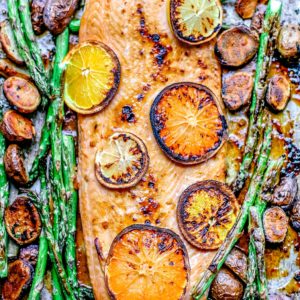
Easy Honey Citrus Sheet Pan Salmon
Flaky salmon is slathered with a finger-licking honey citrus glaze and baked alongside crisped up potatoes and asparagus for an easy weeknight one-pan dinner.
Print
Pin
Servings: 4
Ingredients
- 1 lb salmon fillet or 4 6oz fillets
Garlicky Potatoes.
- 1 lb small potatoes, halved
- 2 TBSP olive oil
- 4 cloves of garlic, minced
- 2 TBSP freshly chopped parsley
- A sprinkle of kosher salt and crackled black pepper
Asparagus.
- 1-2 bunches of asparagus, woody ends broken off See notes.
- 1-2 tsp olive oil
- A sprinkle of kosher salt and cracked black pepper
Honey Citrus Glaze.
- Juice of 1/2 a lime
- Juice of 1/2 a lemon
- Juice of 1/2 an orange
- Juice of 1/2 a grapefruit
- 2 TBSP tamari or low sodium soy sauce
- 1 TBSP honey
- 1 TBSP coconut palm sugar (or brown sugar)
- 1/2-1 TBSP sambal oelek (or Sriracha)
- 3 cloves of garlic, minced
- 1 tsp freshly grated ginger
- 1 TBSP butter
- 1/4 cup cold water
- 2 TBSP corn starch
Instructions
Garlicky potatoes.
- Preheat oven to 400° F. Place the halved potatoes in a large bowl and drizzle with olive oil. Toss to coat. Add the garlic, parsley, salt, and pepper. Toss again to coat. Evenly distribute the potatoes over a baking sheet and set bowl aside for asparagus. With a spoon, scoop up any garlic that has landed on the pan and spoon over potatoes. Any garlic set on the pan will burn and bring on a bitter flavor. Bake the potatoes for 20-30 minutes, or until golden brown, tossing halfway through.
Honey Citrus Glaze.
- Squeeze the lime, lemon, orange, and grapefruit juice into a medium-sized saucepan. Discard any seeds. Add the ingredients from the through to the ginger and whisk until well-combined. Place the saucepan over medium heat and bring to a simmer. Simmer until the mixture thickens, about 10 minutes. Add the butter and stir to melt. If you'd like a thicker consistency (I always do), mix the cold water and corn starch into a small bowl, whisking with a fork until the corn starch has dissolved. Slowly add it to the simmering glaze mixture, stirring constantly until the mixture thickens. Remove from heat and set aside.
Asparagus.
- Break off the woody ends of the asparagus (see notes). Place spears into the bowl your potatoes were in. Drizzle with olive oil and toss. Sprinkle salt and pepper over the spears, and toss again to coat. Set aside.
Salmon.
- Bring the salmon out and set it on the counter 15 minutes before it's set to go into the oven. Bringing the salmon to room temperature will ensure an even cook. Pat the salmon dry with paper towels and sprinkle with salt.
- When the potatoes have crisped, bring the pan out of the oven and set it somewhere safe. Move the oven rack about 6 inches from the broiler and set broiler to high.
- With a spatula move the potatoes to the sides of the pan to make room. Set the salmon down in the middle of the pan. Distribute the asparagus around the sides.
- Carefully pour half of the glaze mixture over the salmon, brushing it with a basting brush to evenly coat. Set the rest of the glaze aside.
- Cut a few thin slices of the remaining citrus fruits and place over the salmon. (Optional.)
- Place the pan under the broiler and broil for about 13-15 minutes. Because every broiler is different, keep a close eye on it. It doesn't hurt to check the internal temp of the salmon at 8-10 minutes in, and monitor it closely after that. You're looking for an internal temperature of 145° F.
- When done, remove the pan from the oven. Carefully discard the fruit slices. Brush the remaining glaze over the salmon, cut the fillets into 4-6 oz portions, and serve.
Notes
- The amount of asparagus is hard to judge as it depends on the spears available to you. Sometimes they're thick, sometimes they're super thin. Judge as best as you can based on the amount of people you are serving. Not into asparagus? Use green beans or broccoli!
- Set your salmon out on the counter about 15 minutes prior to cook time to bring it to room temp. This helps in giving you an even cook with your salmon.
- To get rid of the woody ends on your asparagus, simply hold each spear, one at a time, horizontally between your fingers and your thumbs and bend it until it breaks, as if snapping a stick. The woody end will break off exactly where it should.
- Have leftover salmon? It's great flaked into a salad or wrap for a next-day lunch!